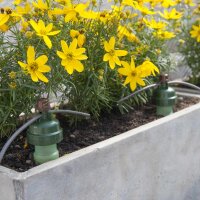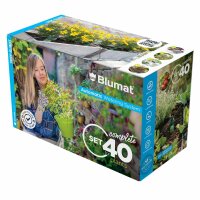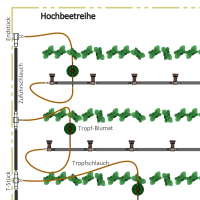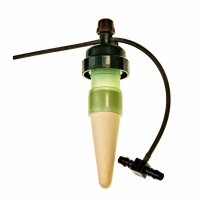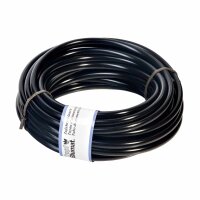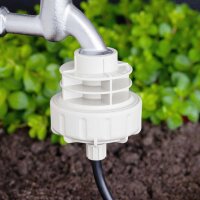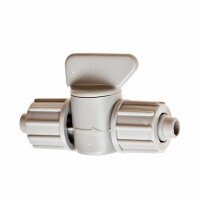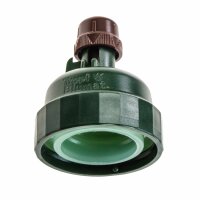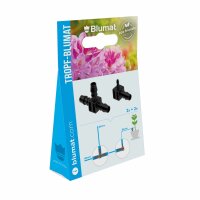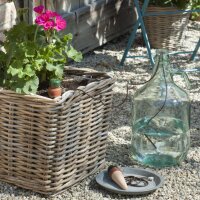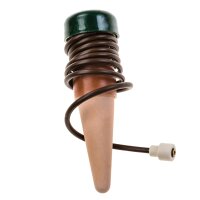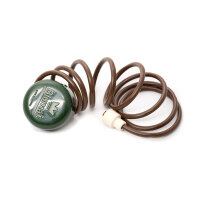Maintenance and care
Pre-requisites for a proper functioning system are: a sufficient water supply, adequate pressure and a correctly adjusted dripper. The simple mechanism and possibilities for individual customizations are hereby particularly advantageous.
In order to avoid handling or adjustment errors and to detect possible faults at an early stage, occasional checks are helpful or sometimes necessary.
First control after initial adjustment (operational set-up)
Visually assess soil moisture after a few days, depending on the weather and the water requirements of the respective plant (however, within a week): Optimal condition: only a small damp area at the dripper location – indication that watering has already taken place. If this is not the case, then adjust slightly > see Settings
At the latest, after the 2^(nd) control and correction, the Tropf-Blumat should be left to work, without constantly being corrected simply because it does not happen to be dripping when one is passing by!
Attending to the running operation of the system:
The water supply in the elevated tank must be routinely topped off – especially important during periods of absence when the water reserve is insufficient for the entire period (let experience be a guide).
Refilling in a timely manner results in less differences in height and therefore in a more even pressure – this is always advantageous!
Careful by systems that are attached to the water mains, the faucet must not be accidently turned off!
Sporadic Control of the Sensor Function
The water volume of the Tropf-Blumat is enough for one garden season for a standard system set-up with normal moisture level settings. By continual use or for Tropf-Blumat with drier settings, it is necessary to check the fill level and to supplement in widely spaced intervals, depending on the aims of the setting. When a frequent loss of water is observed, then the sensors should be checked for possible leakage (incorrect handling, defect).
Unauthorized changes to the moisture settings should absolutely be avoided > for example, by using a cap to secure against easy access (only necessary when access is available to children or uninformed persons in public areas).
Caution: Sensors, which have been pulled out and are lying somewhere still attached to water, can cause significant malfunctions due to excess water (danger of flooding!).
How to handle hose malfunctions
The water supply hose usually does not cause any malfunctions. Likewise, the dripper tubing is not generally susceptible to clogging – for instance, deposits at the end of the tubing can easily be removed by rubbing tubing between the fingers.
Nevertheless, it is still necessary to check the hoses in certain situations. These include factors related to the local water conditions in terms of quality and content, but also to possible algal build-up, for instance, in hoses that are too long and that do not have enough flow to prevent clogging; or also the occasional growth of roots into the tubing.
However, these are not unusual situations, because wherever water flows and is distributed, residues remain or other organisms play a role – one just has to recognize such factors and, if possible, prevent them from occurring.
Occasionally check the flow: flush to detect and eliminate beginning blockage, for instance, once per growing season (for dripper tubing over approx. 70 cm long):
Open the adjusting screw completely and check if a strong jet of water is emitted (flow dependent upon operational pressure). Observe beforehand whether the Tropf-Blumat is dripping and which marking the current setting is on (see Settings), so as to restore to the previous setting after flushing.
Tip: install a mini-hose-connector just before the Tropf-Blumat, this makes it possible to easily disconnect the tubing in order to flush, without having to change the settings.
Eliminate blockages: loosen stubborn deposits by kneading and stretching the hose so that they can be flushed out with the existing operating pressure (this may not be possible with elevated tank systems with a low water column).
Prevent blockages: the use of the Tropf-Blumat System with very hard water (from 25-30° dH (=dGH)) is difficult, in this case, it is advisable to use softened water or, even better, rainwater.
Do not use drip hoses that are too long (max. approx. 100-(150) cm), and cover these longer drip hoses as much as possible so as not to expose them to full direct sunlight, flush more frequently if the water turnover is low.
Instead of long drip hoses, it is recommended, depending on the local conditions, to place the supply hose as close as possible to the areas to be irrigated and to keep the drip hose only about 30-40 cm long, if possible.
When adding fertilizer to the raised tank, choose fertilizer appropriate for the water conditions.
The problem of roots growing into the hose opening – such as often observed with strongly growing plants – can be prevented by using drip hose fasteners.
Damage to drip hoses:
Unfortunately, sometimes animals show an ‘interest’ in the drip tubes which can lead to fine leaks. Here, too, the reduced use of drip hoses is an advantage. And then there are the scissors of the gardener, which does not automatically recognize the drip hose during pruning!
Winter
Getting ready for winter
The entire hose lay-out can basically remain outside without being drained.
Practical experience has also shown that the water-filled Tropf-Blumats can remain in the ground, as well. This is especially advisable for hardy tub plantings (see Winter Operation) in order to avoid having to move the plants around seasonally, even if there might be an occasional loss. If Tropf-Blumats have remained installed, then the water level needs to be controlled in the spring.
Unfortunately, it is not possible to guarantee that the units are absolutely frost hard under harsh frost temperatures. The chances of system failure are, however, minimum.
If summer plantings are to removed anyway, then the Tropf-Blumats can also be removed, cleaned and stored in a dry location.
Caution, winter protection: externally mounted pressure reducers and two-way distributors must be overwintered frost-free!
Winter Operation
Providing evergreen tub plants with water in the winter is difficult and under frosty conditions almost impossible. Therefore, irrigating during the milder winter months is especially important. It is possible to use the Tropf-Blumat-System in winter, as long as the system is only pressurized on mild days (a reinstallation of the pressure reducer for this purpose is necessary).
The system can remain under constant pressure as long as the pressure reducer is located in a frost-free interior and all drip tubing is held in place with hose fasteners. (Otherwise, the dripper hoses could be loosened due to frost build-up.)

